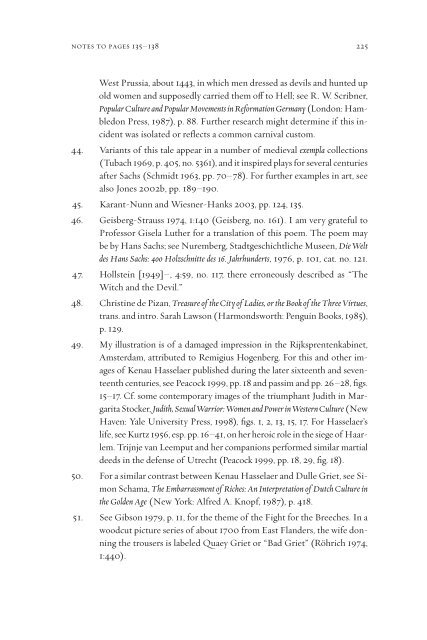Pieter Bruegel and the Art of Laughter - AAAARG.ORG
Pieter Bruegel and the Art of Laughter - AAAARG.ORG
Pieter Bruegel and the Art of Laughter - AAAARG.ORG
Create successful ePaper yourself
Turn your PDF publications into a flip-book with our unique Google optimized e-Paper software.
notes to pages 135–138 225<br />
West Prussia, about 1443, in which men dressed as devils <strong>and</strong> hunted up<br />
old women <strong>and</strong> supposedly carried <strong>the</strong>m oª to Hell; see R. W. Scribner,<br />
Popular Culture <strong>and</strong> Popular Movements in Reformation Germany (London: Hambledon<br />
Press, 1987), p. 88. Fur<strong>the</strong>r research might determine if this incident<br />
was isolated or reflects a common carnival custom.<br />
44. Variants <strong>of</strong> this tale appear in a number <strong>of</strong> medieval exempla collections<br />
(Tubach 1969, p. 405, no. 5361), <strong>and</strong> it inspired plays for several centuries<br />
after Sachs (Schmidt 1963, pp. 70–78). For fur<strong>the</strong>r examples in art, see<br />
also Jones 2002b, pp. 189–190.<br />
45. Karant-Nunn <strong>and</strong> Wiesner-Hanks 2003, pp. 124, 135.<br />
46. Geisberg-Strauss 1974, 1:140 (Geisberg, no. 161). I am very grateful to<br />
Pr<strong>of</strong>essor Gisela Lu<strong>the</strong>r for a translation <strong>of</strong> this poem. The poem may<br />
be by Hans Sachs; see Nuremberg, Stadtgeschichtliche Museen, Die Welt<br />
des Hans Sachs: 400 Holzschnitte des 16. Jahrhunderts, 1976, p. 101, cat. no. 121.<br />
47. Hollstein [1949]–, 4:59, no. 117, <strong>the</strong>re erroneously described as “The<br />
Witch <strong>and</strong> <strong>the</strong> Devil.”<br />
48. Christine de Pizan, Treasure <strong>of</strong> <strong>the</strong> City <strong>of</strong> Ladies, or <strong>the</strong> Book <strong>of</strong> <strong>the</strong> Three Virtues,<br />
trans. <strong>and</strong> intro. Sarah Lawson (Harmondsworth: Penguin Books, 1985),<br />
p. 129.<br />
49. My illustration is <strong>of</strong> a damaged impression in <strong>the</strong> Rijksprentenkabinet,<br />
Amsterdam, attributed to Remigius Hogenberg. For this <strong>and</strong> o<strong>the</strong>r images<br />
<strong>of</strong> Kenau Hasselaer published during <strong>the</strong> later sixteenth <strong>and</strong> seventeenth<br />
centuries, see Peacock 1999, pp. 18 <strong>and</strong> passim <strong>and</strong> pp. 26–28, figs.<br />
15–17. Cf. some contemporary images <strong>of</strong> <strong>the</strong> triumphant Judith in Margarita<br />
Stocker, Judith, Sexual Warrior: Women <strong>and</strong> Power in Western Culture (New<br />
Haven: Yale University Press, 1998), figs. 1, 2, 13, 15, 17. For Hasselaer’s<br />
life, see Kurtz 1956, esp. pp. 16–41, on her heroic role in <strong>the</strong> siege <strong>of</strong> Haarlem.<br />
Trijnje van Leemput <strong>and</strong> her companions performed similar martial<br />
deeds in <strong>the</strong> defense <strong>of</strong> Utrecht (Peacock 1999, pp. 18, 29, fig. 18).<br />
50. For a similar contrast between Kenau Hasselaer <strong>and</strong> Dulle Griet, see Simon<br />
Schama, The Embarrassment <strong>of</strong> Riches: An Interpretation <strong>of</strong> Dutch Culture in<br />
<strong>the</strong> Golden Age (New York: Alfred A. Knopf, 1987), p. 418.<br />
51. See Gibson 1979, p. 11, for <strong>the</strong> <strong>the</strong>me <strong>of</strong> <strong>the</strong> Fight for <strong>the</strong> Breeches. In a<br />
woodcut picture series <strong>of</strong> about 1700 from East Fl<strong>and</strong>ers, <strong>the</strong> wife donning<br />
<strong>the</strong> trousers is labeled Quaey Griet or “Bad Griet” (Röhrich 1974,<br />
1:440).












